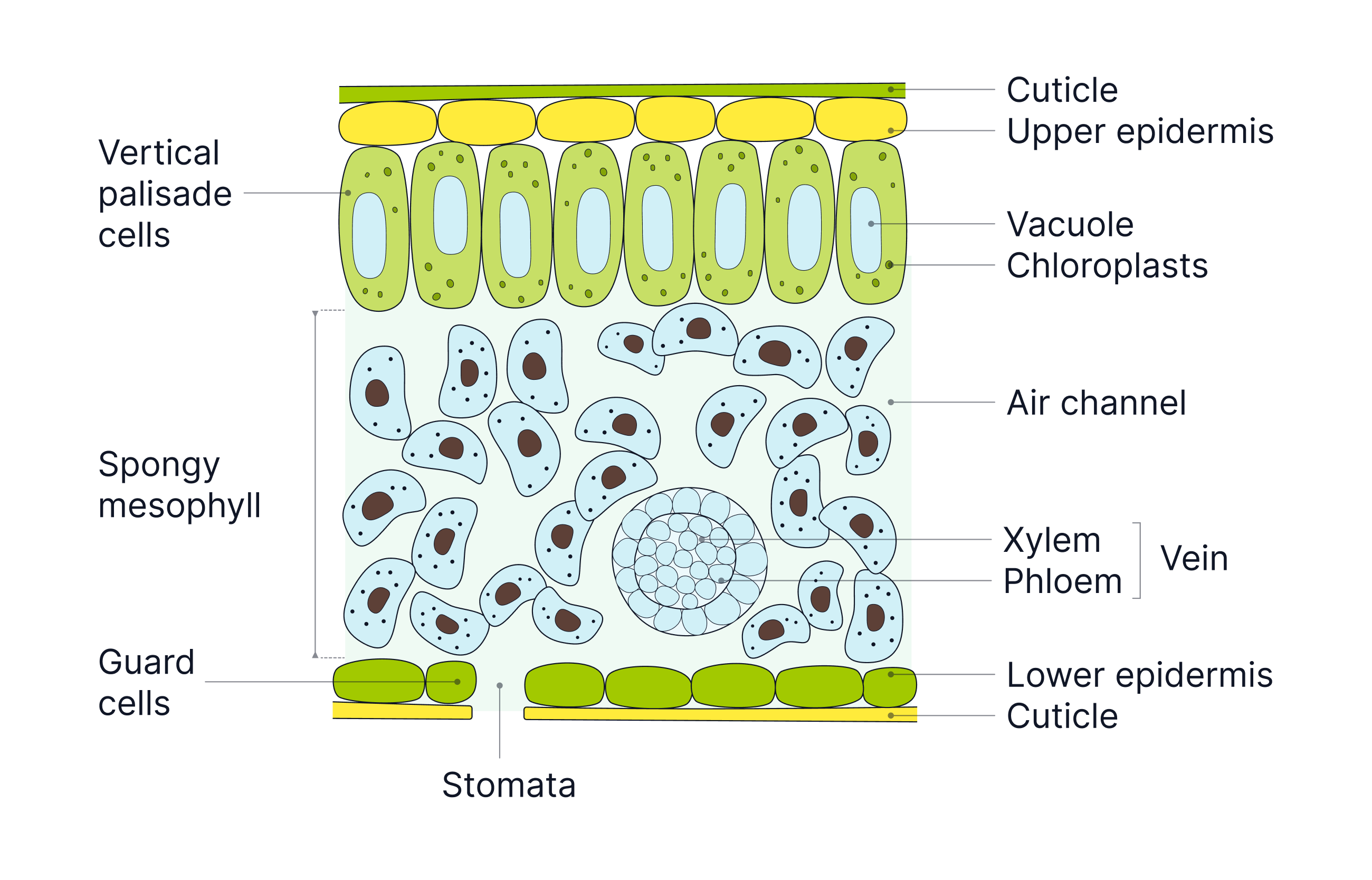Gas exchange in leaves
Joe Wolfensohn
Teacher

Contents
Recall Questions
This topic requires prior knowledge of leaf structure and the role of stomata in gas movement during photosynthesis from GCSE. You can test your knowledge on these below.
What is the function of the counter-current mechanism in fish gills?
It maintains a steep oxygen concentration gradient along the entire length of the gill by ensuring oxygen-rich water always meets blood with a lower concentration of oxygen, maximising oxygen uptake.
How do fish ventilate their gills to ensure a continuous flow of water?
The mouth opens, lowering pressure to draw in water, and then closes, increasing the pressure and forcing water over the gills as the operculum opens.
How are gill lamellae adapted for efficient gas exchange?
They have a large surface area, thin epithelium for a short diffusion distance, and a rich capillary network to maintain a steep diffusion gradient.
Topic Explainer Video
Check out this @JoeDoesBiology video that explains gas exchange in leaves or read the full notes below. Once you've gone through the whole note, try out the practice questions!
Intro to Gas Exchange in Leaves
Plants require oxygen for respiration and carbon dioxide for photosynthesis. Gas exchange in leaves occurs primarily through stomata, which open and close to regulate the movement of gases.
How Gas Exchange Occurs in Leaves
1. During the day, when the rate of photosynthesis exceeds the rate of respiration, there is a net uptake of carbon dioxide and a net output of oxygen.
-
Carbon dioxide diffuses into the leaf for photosynthesis.
-
Oxygen, a byproduct, diffuses out (through the stomata).
2. During the night, when photosynthesis stops but respiration continues:
-
Oxygen diffuses in for respiration.
-
Carbon dioxide is released as a waste product (through the stomata).
Stomata can close at night to reduce water loss. When this occurs, cells can use oxygen in the air spaces of the spongy mesophyll tissue for respiration.
Adaptations of the Leaf for Gas Exchange
1. Large Surface Area
-
Maximises light absorption and increases the rate of gas exchange. This is because if the surface area is larger there are likely a greater number of stomata.
2. Thin Structure
-
Provides a short diffusion distance for gases to reach photosynthetic cells quickly.
3. Stomata
-
Pores mainly on the lower epidermis, allowing gas exchange and controlling water loss from the leaf.
4. Interconnecting Air Spaces in the Spongy Mesophyll
-
Gases diffuse quickly and easily throughout the leaf. For example, carbon dioxide diffuses from the air in the air spaces to the palisade mesophyll cells.
5. Guard Cells
-
Control the opening and closing of stomata to regulate gas exchange and prevent excessive water loss.
Labelled Diagram of Leaf Tissues and Their Adaptations
Here’s a diagram of the cross-section of a leaf, showing the key tissues:

|
Tissue |
Function |
|---|---|
|
Waxy Cuticle |
Reduces water loss by evaporation. |
|
Upper Epidermis |
Transparent to allow light to penetrate to mesophyll cells. |
|
Palisade Mesophyll |
Contains many chloroplasts, where most photosynthesis occurs. |
|
Spongy Mesophyll |
Large air spaces allow for efficient diffusion of gases. |
|
Lower Epidermis |
Contains stomata for gas exchange. |
|
Guard Cells |
Control stomatal opening and closing to balance gas exchange and water loss. |
Why don’t leaves require a specialised transport system for gases?
-
No living cell is far from the external air, and therefore a source of oxygen and carbon dioxide.
-
Diffusion takes place in the air (gas) which is more rapid than water.
-
Plants also have a low metabolic rate and so their demand for gaseous exchange is not as great as active mammals.
Key Terms
-
Stomata: Pores in the leaf that allow gas exchange.
-
Guard Cells: Cells that control the opening and closing of stomata.
-
Palisade Mesophyll: Layer containing many chloroplasts for photosynthesis.
-
Spongy Mesophyll: Layer with air spaces for rapid gas diffusion.
-
Waxy Cuticle: Reduces water loss while still allowing light to pass through.
Exam Tip
When explaining gas exchange in leaves, don’t forget that during the day plants will be doing both photosynthesis (CO₂ in, O₂ out) and respiration (O₂ in, CO₂ out). However, during the day, when light intensity is high, the rate of photosynthesis will exceed the rate of respiration.
Explain how the structure of a leaf is adapted for efficient gas exchange. (6 marks)
-
The leaf has a large surface area with many stomata to allow for gas exchange. (1)
-
It is thin, ensuring a short diffusion distance for gases. (1)
-
The stomata allow gases to enter and exit the leaf via diffusion. (1)
-
Guard cells control the opening and closing of stomata to regulate gas exchange and water loss. (1)
-
The spongy mesophyll has air spaces, allowing rapid diffusion of gases. (1)
-
The palisade mesophyll contains many chloroplasts to maximise photosynthesis, maintaining a steep concentration gradient for CO₂. (1)
Practice Question
Try to answer the practice question from the TikTok on your own, then watch the video to see how well you did!